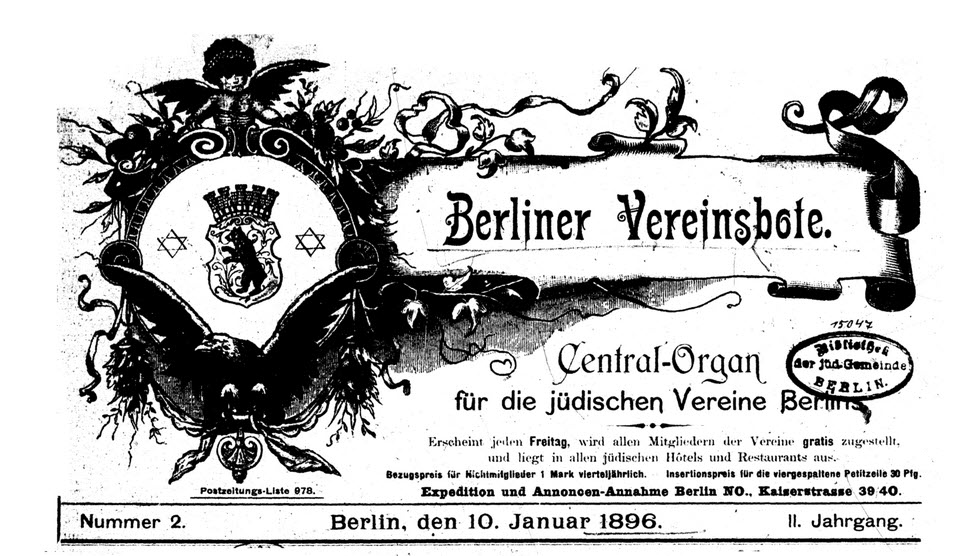Welcome to another installment of the Glocal Notes “Resource Spotlight” series! In these posts, we highlight digital resources relevant to international and area studies. These posts have two goals: 1) familiarize researchers with resources, often published abroad, that they may not be aware of, but which could be of tremendous use to their research and 2) explain how to use these resources, saving researchers’ time and allowing them to concentrate their efforts on evaluating the resources’ usefulness in the context of their research question. This week’s post is about Compact Memory, a digitization initiative of the Goethe University Frankfurt, which provides free, online access to important German-Jewish periodicals.

Masthead of the January 10, 1986 issue of Berliner Vereinsbote, one of the digitized newspapers available through the Compact Memory digital collection.
Compact Memory provides online access to 172 important newspapers and journals published by the German-Jewish community. Compact Memory is an initiative of the Goethe University Frankfurt University Library and a part of their rich digital collection of Judaica materials. This collection includes resources on a variety of subjects, including academic texts, religion, politics, literature, and social life, published during the years 1768-1938. As such, it is an invaluable resources to researchers, in Jewish Studies and beyond, interested in these topics. This resource is both freely available and easy to use.
The impact of this digitization effort is well summarized on the Compact Memory project’s “About” page:
Due to the condition of many historical journals, as well as wartime losses, the originals of these journals are no longer to be found in any library in this completeness. The journals – and fragments of journals – have been digitized and assembled from different library collections, and are now almost completely available electronically for the first time. They can be printed or saved; some titles have been edited with OCR and are full text searchable. Almost 80.000 single articles of more than 10.000 authors are registered bibliographically. Currently the amount of digitized pages adds up to 750.000. Missing volumes are continuously complemented, and further relevant journals of the German speaking area are added.
The project’s efforts to make these materials available is a fantastic example of the potential of digitization to offer access to materials in unprecedented ways. As it draws on holdings from multiple libraries, Compact Memory is able to provide access to resources beyond what would be available at any single library. Additionally, given the fragile condition of this material (newspapers, in particular, have a relatively short shelf life), digitization efforts ensure that the content of these texts can be accessed and used by many researchers without further compromising the materials themselves, ultimately enabling their long-term preservation. Finally, these digitized archives are integrated into the Europeana Digital Library, an online portal that facilitates access to hundreds of digital collections from across Europe. This integration not only allows users unaware of Compact Memory to discover these resources, but also allows researchers to simultaneously discover relevant materials from other collections. (For more information about Europeana, see our Glocal Notes post from April 2014.)
As mentioned above, the texts in the Compact Memory project can be identified through the Europeana Digital Library portal. Additionally, it is possible to search for relevant articles through the Goethe University Frankfurt Digital Collections search interface. (You can search just Compact Memory, or search all of the library’s digital collections.) The interface offers pretty robust advanced search options and, as mentioned above, some of the materials in Compact Memory are OCR-enabled, which means it is possible to search the full-text of the articles themselves for keywords. For those not yet in-the-know, OCR stands for Optical Character Recognition. This means that the image files of the scanned articles have been digitally processed, with the help of some pattern recognition algorithms, to identify the text represented within. While this is something that we, as human readers, can do easily, it is not necessarily a trivial task for a computer. As such, OCR texts often contain mistakes, filling in gibberish where the algorithm was thrown off by a printing mistake, irregular font, or other obstacle. However, these tools are being improved constantly and they give researchers an additional point of entry into the materials.
While these search options are very rich, the ability to browse this collection will be of particular interest to researchers. All 172 periodicals in Compact Memory can be browsed through a robust interface, and it is also possible to browse these materials within the larger Judaica collection. When browsing Compact Memory, the default setting is to display the periodicals in alphabetical order, by title. However, it is possible to toggle the sort to display titles by Author/Collaborator, Place, Printer/Publisher, or Year. Additional nuance is provided by several filters, found on the right side of the screen, that allow researchers to limit their results by Language (Hebrew, German, or English), Publisher, Place of Publication (currently, 44 cities are represented), and Document Type (journal or newspaper). Each issue of a title is available as a downloadable PDF file, allowing researchers to access the materials both online and off, on whatever device is they prefer (including printing out the sections they wish to examine in depth). Many researchers using digitized materials may already be painfully aware that this portability is not always the case. Often, online collections restrict the user to a clunky online-only viewing interface, limit printing, or provide off-line viewing only through proprietary software. Finally, each record is linked directly to a record for that item University Library’s online catalog, providing an additional access point to other materials that may be of interest.
Overall, Compact Memory is a fantastic resource for scholars working in Jewish Studies. Not only does it provide access to a rich collection of otherwise hard-to-find journals and newspapers, it does so through a robust interface that allows researchers to easily locate and access the materials they need.

